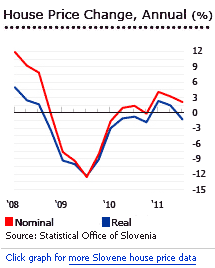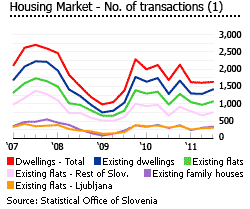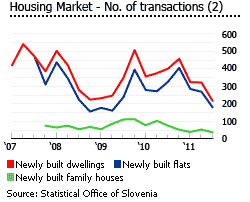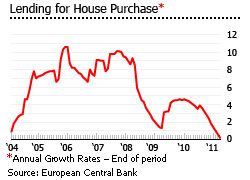Slovenia's housing market rapidly cooling
A weak new government takes over in the middle of the euro storm
The centre-left candidate Zoran Janković, a former major of Ljubljana, won a narrow victory in the Republic of Slovenia’s presidential elections on December 2011 for the Positive Slovenia party, but failed to be elected as prime minister. The new government was formed instead by a right-leaning coalition of five parties, led by Janez Janša, president of the second-placed Slovenian Democratic Party.

As a eurozone member, Slovenia´s housing market is suffering from the the euro’s crisis and possible eurozone recession. Until the euro crisis heads towards a real solution, uncertainty is likely to be the main driver.
The new government has already announced new austerity measures, including reducing pay cheques for government employees by 10% starting June 2012. In addition, the new government has reduced its support for the construction business, and seems likely to introduce a new real estate tax.
A vulnerable banking sector
The banking sector is weak and vulnerable. Slovenia’s credit ratings reflect the financial difficulties:
- Moody´s has recently downgraded for the second time in three months Slovenia´s local and foreigncurrency government bond ratings by one notch to A1 from Aa3, and placed the ratings on review for possible further downgrade.
- Standard & Poor´s has placed its ´AA´ longterm and ´A1+´ shortterm sovereign credit ratings on the Republic of Slovenia on review for possible further downgrade.
Slovenia´s banking sector is dominated by state-owned banks which control more than 40 percent of the market, while France´s Societe Generale, Italy´s Unicredit and a number of Austrian banks are also present. The Bank of Slovenia has said that the Slovenian banks´ financial results in 2012 are expected to be poor and that they will need further injection of capital. The growing risk that a new Slovenian government intervention to rescue the banking sector may be necessary, is one of the main reasons motivating the downgrades.
Recovery fading fast

Uncertainty seems to have spread to the Slovenian housing markets: though the house price index rose 2.13% during the year to the third quarter, according to the Statistical Office of Slovenia (SORS), dwelling prices in Slovenia moved on average 2.4% lower q-o-q during the third quarter. Newly built flat prices fell sharply, and newbuild sales went down significantly.
Rents are already going down. The credit rating cuts by Moodys last year pushed up the price of mortgage loans, while the difficulties of the banking sector reduced the banks’ willingness to make loans for house-purchases.
Newly-built house prices are falling:
- The newly built dwellings price index rose 3.16% during the year to the third quarter, but during the third quarter dwelling prices fell by 4.22%.
- The price index of newly built flats rose 5.28% during the year to the third quarter, again with momentum falling fast. In Q3 prices fell 5.23% q-o-q.
- The price index of newly built family houses fell 3.24% during the year to the third quarter, also with momentum weakening (prices were 6.37% up y-o-y to Q1, but 6.48% down y-o-y to Q2).
Existing dwellings have been less affected:
- The price index of existing dwellings rose 1.17% during the year to the third quarter of 2011. In the second and third quarter, prices fell by 0.91% and 0.94% q-o-q respectively.
- The price index of existing flats rose 1.38% during the year to the third quarter of 2011. In Q2 existing flats prices rose 0.54% q-o-q, but fell in Q3 by 0.91% q-o-q.
- The price index of existing family houses rose 0.86% during the year to the third quarter. In Q2 and Q3 existing family house prices fell 4.29% and 0.98% q-o-q respectively.

Fresh data from the Office of Slovenia (SORS) shows a supply side slowdown. "In comparison with October 2010, the value of construction put in place in October 2011 decreased by more than 25%".
Sales of real estate to foreigners have been limited. From January 2004 to August 2011, foreigners bought only 3775 properties according to the Slovenia Tax Administration (DURS). Most buyers were from United Kingdom (32,8%), Italy (28.9%), Austria (10.9%) and Germany (6%).
Mortgage market is sharply slowing down

Lending for house purchase is rapidly slowing down, as both demand and supply of financing are weak and vulnerable. Monthly data from the EBC show that lending for house purchase was up only 0.2% y-o-y to October 2011, whereas it was up 4% to October 2010. Lending is falling because of worsening conditions on the financial markets and the economic slowdown. Coherently with other economic and financial aggregates, the mortgage market is indicating a likely "double-dip" of the Slovenian economy.
Interest rate movements

The recent dynamic of the interest rates clearly reflects the euro zone turbulence, as the ECB struggle to provide liquidity to the financial system and to restore market confidence. The 8th December the head of the ECB Mario Draghi announced the second cut in the policy rate in three weeks as well as a package of non-conventional monetary measures aimed at injecting liquidity into the troubled European banking system. Now the policy rate is at the historic low of 1%.
The floating interest rate (up to one year initial rate fixation) rose again to 3.88% in October 2011, the highest since August 2009, after the European Central Bank (ECB) increased the euro repo rate by 25 basis points to 1.25% in April. The ten year fixed rate-mortgage rate in October 2011 rose to 6.08% compared with 5.52% in October 2010. However it is unclear interest whether in fact mortgage rates for housing loans in Slovenia will decrease, despite the latest cuts by the ECB.
Growth likely to be weak
Slovenia’s economy grew by 1% in 2011, and is expected to grow by 0.3% in 2012 and 0.8% in 2013 (OECD forecast November 2011). The budget deficit should progressively decrease from 5.3% in 2011, but the economy is very weak:
- Private consumption has not yet recovered from the aftermath of the financial crisis, and is expected to stagnate with 0.1% growth in 2011, 0.2% in 2012 and 0.8%.
- Unemployment is expected to be 8.1% in 2011, up from 5.9% in 2009 and to rise to 8.5% in 2012.

The bleak outlook depends on the combination of weak external environment, and a deleveraging corporate sector, say OECD economists. Activity should recover gradually in 2013 as confidence recovers.
In summary, the Slovenian housing market, after a rebound, is now rapidly cooling. The main driver of this renewed slowdown is the intrinsic fragility of the banking sector, exacerbated by the euro storm and the likely recession in 2012. The prices of newly built houses show a worse trend then those of existing dwellings. Transactions are stagnating as the economy worsens, and lending for house purchases is also rapidly slowing.